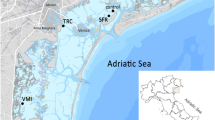Abstract
The feasibility of using lab-cultured amphipods Corophium multisetosum (Stock 1952) to evaluate the toxicity of contaminants present within marine sediments was studied. This was done by comparing the sensitivity of lab-cultured amphipods in a cadmium toxicity test and to toxic sediment samples, during a 10-days bioassay, with field collected individuals. Different responses were observed between field and cultured individuals. Cadmium test indicated high temporal variability in the LC50 values of field amphipods (2.40–6.55 mg L−1). Sensitivity of cultured amphipods was within the seasonal range of the field individuals (5.81 mg L−1, LC50). However, culture amphipods showed much lower sensitivity in toxic sediment samples. Our results indicate that sensitivity should be determined using a sediment matrix, if the assessment of toxicity is based upon bioassays performed with cultured burrower-amphipods.



Similar content being viewed by others
References
ASTM (1990) Standard guide for conducting 10-day static sediment toxicity tests with marine and estuarine amphipods. American Society for Testing and Materials, Philadelphia, p 24
Bellas J, Beiras R, Mariño-Balsa JC, Fernández N (2005) Toxicity of organic compounds to marine invertebrate embryos and larvae: a comparison between the sea urchin embryogenesis bioassay and alternative test species. Ecotoxicology 14:337–353
Borja A, Tueros I, Belzunce MJ, Galparsoro I, Garmendia JM, Revilla M, Solaun O, Valencia V (2008) Investigative monitoring within the European Water Framework Directive: a coastal blast furnace slag disposal as an example. J Environ Monit 10:453–462
Casado-Martinez MC, Forja JM, Del Valls TA (2007) Direct comparison of amphipod sensitivities to dredged sediments from Spanish ports. Chemosphere 68:677–685
Ciarelli S, Vonck WAPMA, van Straalen NM (1997) Reproducibility of spikedsediment bioassays using the marine benthic amphipod, Corophium volutator. Mar Environ Res 43:329–343
Cunha MR, Moreira MH, Sorbe JC (2000) The amphipod Corophium multisetosum (Corophiidae) in Ria de Aveiro (NW Portugal). II. Abundance, biomass and production. Mar Biol 137:651–660
DeWitt TH, Swartz RC, Lamberson JO (1989) Measuring the acute toxicity of estuarine sediments. Environ Toxicol Chem 8:1035–1048
Environment Canada (2002) Biological test method. Reference method for determining the toxicity of sediment using luminescent bacteria in a solid-phase test. Report EPS 1/RM/42, pp 26
Kater BJ, Hannewijk A, Postma JF, Dubbeldam M (2000) Seasonal changes in acute toxicity of cadmium to amphipod Corophium volutator. Environ Toxicol Chem 19:3032–3035
McGee BL, Wright DA, Fisher DJ (1998) Biotic factors modifying acute toxicity of aqueous cadmium to the estuarine amphipod Leptocheirus plumulosus. Arch Environ Contam Toxicol 34:34–40
OSPAR Commission (2005) OSPAR protocols on methods for the testing of chemicals used in the offshore oil industry. Reference number: 2005–2011 (a revised version of agreement 1995–2007), pp 26
Pérez V (2006) La utilización de anfípodos para la evaluación integrada de la calidad de sedimentos marinos y estuáricos: su aplicación en la Costa Vasca. Doctoral Thesis, Universidad del País Vasco, pp 181
Pérez-Landa V, Belzunce MJ, Franco J (2008) The effect of seasonality and body size on the sensitivity of marine amphipods to toxicants. Bull Environ Contam Toxicol 81:548–552
Peters C, Ahlf W (2005) Reproduction of the estuarine and marine amphipod Corophium volutator (Pallas) in laboratory for toxicity testing. Chemosphere 59:525–536
Ré A, Freitas R, Sampaio L, Rodriguez AM, Quintino V (2009) Estuarine sediment acute toxicity testing with the European amphipod Corophium multisetosum Stock, 1952. Chemosphere 76:1323–1333
Redmond AM, Lamberson JO, Cole FA, Swartz C (1994) Preliminary culture and life-cycle experiments with the benthic amphipod Ampelisca abdita. Environ Toxicol Chem 13:1355–1365
Riba I, Forja JM, Gómez-Parra A, DelValls TA (2004) Sediment quality in littoral regions of the Gulf of Cádiz: a triad approach to address the influence of mining activities. Environ Pollut 132:341–353
Robinson AM, Lamberson JO, Cole FA, Swartz RC (1988) Effects of culture conditions on the sensitivity of a phoxocephalid amphipod, Rhepoxynius abronius, to cadmium in sediment. Environ Toxicol Chem 7:953–959
Schipper CA, Burgess RM, Van Den Dikkenberg B, Kater BJ, Stronkhorst J (1999) Standard operating procedure specie-01 marine amphipod Corophium volutator mortality sediment toxicity test. RIKZ Report No. Specie-01, The Netherlands, pp 16
Schipper CA, Dubbeldam M, Feist SW, Rietjens IMCM, Murk AT (2008) Cultivation of the heart urchin Echinocardium cordatum and validation of its use in marine toxicity testing for environmental risk assessment. J Exp Mar Biol Ecol 364:11–18
Stronkhorst J, Schipper CA, Brils J, Dubbeldam M, Postma JF, van de Hoeven N (2003) Using marine bioassays to classify the toxicity of dutch harbour sediments. Environ Toxicol Chem 22:1525–1547
USEPA (2001) Method for assessing the chronic toxicity of marine and estuarine sediment-associated contaminants with the amphipod Leptocheirus plumulosus. EPA 600/R-01/020, pp 102
Acknowledgments
We thank Fundación Centros Tecnológicos–Iñaki Goenaga and Ministerio de Educación y Ciencia and Fondo Social Europeo (Torres Quevedo, PTQ04-3-0597) for supporting I. Menchaca (PhD fellowship), Natalia Montero (specialization fellowship) and J.M. Garmendia. This paper constitutes part of the PhD Thesis of I. Menchaca. We wish to thank several people from AZTI, especially to Dr. Joana Larreta, for their help in the laboratory analyses. The authors are grateful to Professor Michael Collins (School of Ocean and Earth Science, University of Southampton, UK) and Dr. Paul de Bruyn for providing some useful suggestions. This is contribution number 489 of AZTI-Tecnalia Marine Research Division.
Author information
Authors and Affiliations
Corresponding author
Rights and permissions
About this article
Cite this article
Menchaca, I., Belzunce, M.J., Franco, J. et al. Sensitivity Comparison of Laboratory-Cultured and Field-Collected Amphipod Corophium multisetosum in Toxicity Tests. Bull Environ Contam Toxicol 84, 390–394 (2010). https://doi.org/10.1007/s00128-010-9960-9
Received:
Accepted:
Published:
Issue Date:
DOI: https://doi.org/10.1007/s00128-010-9960-9




